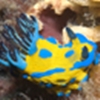General Description
Body shape slug-like with gill structures visible as multiple projections along the sides body. Pattern includes shades or colours of white and/or black. Animal up to 1 cm long.
Biology
This is one of many dotid nudibranch species worldwide. They all feed on and lay eggs in winding wavy ribbons on hydroids. There are a number of Doto nudibranchs in Victoria that are yet to be named.
Habitat
Near or on hydroids under rocks or crawling about on algal tips, to depth of 85 m.
Coastal shores
Reefs
Distribution guide
South-eastern Australia.
Species Group
Nudibranchs and allies › Nudibranchs
Depth
Shore (0-1 m)
Shallow (1-30 m)
Deep ( > 30 m)
Water Column
Max Size
1 cm
Diet
Carnivore
Commercial Species
No
Global Dispersal
Native to Australia
Identify
Conservation Status
- DSE Advisory List : Not listed
- EPBC Act 1999 : Not listed
- IUCN Red List : Not listed






